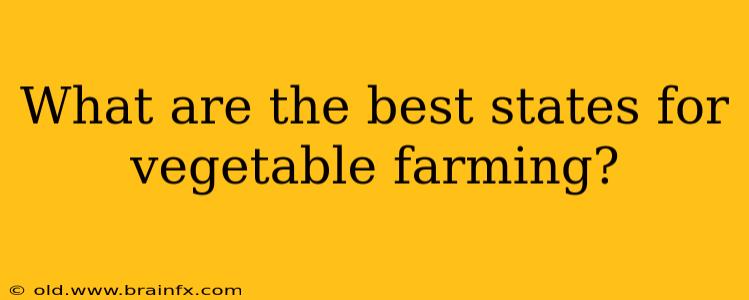The United States boasts a diverse range of climates and agricultural landscapes, making it a prime location for vegetable production. But which states truly reign supreme when it comes to vegetable farming? The answer isn't a simple one, as "best" depends on several factors including the specific vegetable, farming practices, and market demand. However, several states consistently stand out for their significant contributions to the nation's vegetable supply and their favorable growing conditions.
Top States for Vegetable Production: A Comprehensive Overview
Several key factors contribute to a state's success in vegetable farming. These include:
- Climate: A long, warm growing season with sufficient sunlight is crucial for many vegetables.
- Soil Quality: Rich, fertile soil provides essential nutrients for healthy plant growth.
- Water Availability: Access to reliable irrigation is vital, especially in drier regions.
- Infrastructure: Efficient transportation networks are needed to get produce to market quickly.
- Labor Force: A skilled and available workforce is essential for planting, harvesting, and processing.
Considering these factors, let's explore some of the leading states for vegetable farming:
1. California: The Undisputed King
California consistently ranks as the top vegetable-producing state. Its diverse microclimates, from the fertile Central Valley to the coastal regions, allow for year-round cultivation of a wide variety of vegetables. California's advanced irrigation systems and extensive agricultural infrastructure further contribute to its dominance. Key vegetables: Lettuce, tomatoes, broccoli, carrots, onions, and strawberries.
2. Florida: Sunshine State Bounty
Florida's warm climate and ample sunshine provide ideal conditions for growing many vegetables, particularly during the winter months when production slows down in other parts of the country. The state's proximity to major markets in the eastern United States also gives it a significant advantage. Key vegetables: Tomatoes, cucumbers, peppers, and green beans.
3. Washington: A Northwest Powerhouse
Washington State, particularly the Yakima Valley, boasts a unique combination of fertile soil, abundant water resources, and a long growing season, making it a leading producer of several key vegetables. The state's commitment to sustainable agricultural practices further enhances its reputation. Key vegetables: Potatoes, onions, sweet corn, and asparagus.
4. Texas: Vast Landscapes, Diverse Crops
Texas's size and diverse climates allow for the cultivation of a wide range of vegetables. While the state's hot summers can be challenging, efficient irrigation and advancements in drought-resistant varieties have helped expand vegetable production considerably. Key vegetables: Onions, peppers, tomatoes, and spinach.
5. Arizona: Desert Farming Innovation
Arizona's success in vegetable farming is a testament to innovative irrigation techniques and advanced agricultural technologies. Despite its arid climate, the state leverages water-efficient methods to cultivate various vegetables, particularly during the winter months. Key vegetables: Lettuce, broccoli, and carrots.
Factors Beyond State Lines
While these states consistently rank high in vegetable production, it's important to consider other factors that influence the success of vegetable farming:
- Specific Vegetable Type: The optimal growing conditions vary widely depending on the vegetable. For example, potatoes thrive in cooler climates, while peppers require a warm environment.
- Local Market Demand: Proximity to major population centers and efficient transportation networks are crucial for maximizing profitability.
- Technological Advancements: Innovation in irrigation, pest control, and seed development plays a significant role in boosting yields and improving efficiency.
Conclusion: A Dynamic Agricultural Landscape
The best states for vegetable farming are constantly evolving, influenced by climate change, technological innovation, and shifting market demands. However, California, Florida, Washington, Texas, and Arizona consistently demonstrate their prowess in vegetable production, showcasing the diverse agricultural potential across the United States. Further research into specific vegetables and regional variations will provide even more detailed insights into this dynamic and vital sector of the American economy.

